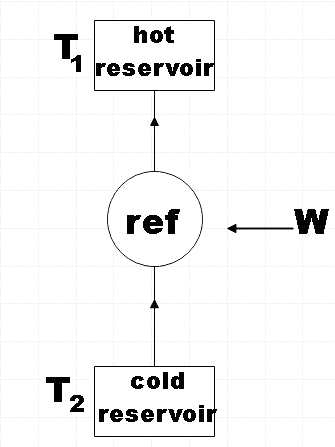
A domestic refrigerator working between melting point of ice and room temperature $27{}^\circ C$ is found to freeze 2kg of water at $0{}^\circ C$ in 1 hour. Calculate the power consumed under ideal conditions given latent heat of fusion of ice $335\times {{10}^{3}}J$
Answer
551.4k+ views
Hint: As a first step, you could recall the expression for coefficient of performance and then rearrange the same to get the energy supplied or the work done on the refrigerator. Substitute the expression for heat supplied in terms of latent heat of fusion of ice. This work done per unit time will give us the required power consumed.
Formula used:
Coefficient of performance of refrigerator,
$COP=\dfrac{{{Q}_{2}}}{W}=\dfrac{{{T}_{2}}}{{{T}_{1}}-{{T}_{2}}}$
Heat supplied,
$Q=m{{L}_{f}}$
Complete answer:
In the question, we are given a domestic refrigerator that works between the melting point of ice and room temperature. It is also found that this refrigerator freezes 2kg of water at $0{}^\circ C$ in a duration of 1 hour. We are asked to find the power consumed under ideal conditions. We are also given the value of latent heat of fusion of ice as,
${{L}_{f}}=335\times {{10}^{3}}J$ ………………………………………….. (1)
We are given the room temperature as,
${{T}_{1}}=27{}^\circ C=\left( 27+273 \right)K=300K$
We know that the melting point of ice is$0{}^\circ C$, therefore,
${{T}_{2}}=0{}^\circ C=\left( 0+273 \right)K=273K$
We know that the coefficient of performance (COP) of a refrigerator is given by,
$COP=\dfrac{{{Q}_{2}}}{W}=\dfrac{{{T}_{2}}}{{{T}_{1}}-{{T}_{2}}}$
Where, ${{Q}_{2}}$ is the heat supplied and W is the input work on the refrigerator.
Therefore, we see that the amount of energy supplied to the refrigerator is given by,
$W=\dfrac{{{T}_{1}}-{{T}_{2}}}{{{T}_{2}}}\times {{Q}_{2}}$ …………………………………… (2)
But we know that heat supplied for freezing $mkg$ of a substance is given by,
$Q=m{{L}_{f}}$
Where, ${{L}_{f}}$ is the latent heat of fusion.
Here, the heat supplied would be,
${{Q}_{2}}=2\times 335\times {{10}^{3}}J=670\times {{10}^{3}}J$ …………………………………………… (3)
Substituting (3) in (2) we get,
$W=\dfrac{300-273}{273}\times 670\times {{10}^{3}}$
$\therefore W=66.26\times {{10}^{3}}J$
Therefore we found that in one hour the refrigerator is supplied with $66.26KJ$ energy to freeze 2kg of water. You may recall that power is the work done per unit time. So,
$P=\dfrac{W}{t}$
Substituting the values,
$P=\dfrac{66.26\times {{10}^{3}}J}{1hr}$
$\Rightarrow P=66.26KJh{{r}^{-1}}$
But we know that,
$1J/hr=2.78\times {{10}^{-7}}kW$
$\Rightarrow P=66.26\times {{10}^{3}}\times 2.78\times {{10}^{-7}}kW$
$\therefore P=184.20\times {{10}^{-4}}kW=18.42W$
Therefore, we found that the power consumed by the refrigerator under ideal conditions is 18.42W.
Note:
The refrigeration cycle would look something like this,

From the figure you will get a clear idea as to how a refrigerator works. The refrigerant which is one among the basic components is found to absorb the heat inside the fridge and thereby cooling down the air.
Formula used:
Coefficient of performance of refrigerator,
$COP=\dfrac{{{Q}_{2}}}{W}=\dfrac{{{T}_{2}}}{{{T}_{1}}-{{T}_{2}}}$
Heat supplied,
$Q=m{{L}_{f}}$
Complete answer:
In the question, we are given a domestic refrigerator that works between the melting point of ice and room temperature. It is also found that this refrigerator freezes 2kg of water at $0{}^\circ C$ in a duration of 1 hour. We are asked to find the power consumed under ideal conditions. We are also given the value of latent heat of fusion of ice as,
${{L}_{f}}=335\times {{10}^{3}}J$ ………………………………………….. (1)
We are given the room temperature as,
${{T}_{1}}=27{}^\circ C=\left( 27+273 \right)K=300K$
We know that the melting point of ice is$0{}^\circ C$, therefore,
${{T}_{2}}=0{}^\circ C=\left( 0+273 \right)K=273K$
We know that the coefficient of performance (COP) of a refrigerator is given by,
$COP=\dfrac{{{Q}_{2}}}{W}=\dfrac{{{T}_{2}}}{{{T}_{1}}-{{T}_{2}}}$
Where, ${{Q}_{2}}$ is the heat supplied and W is the input work on the refrigerator.
Therefore, we see that the amount of energy supplied to the refrigerator is given by,
$W=\dfrac{{{T}_{1}}-{{T}_{2}}}{{{T}_{2}}}\times {{Q}_{2}}$ …………………………………… (2)
But we know that heat supplied for freezing $mkg$ of a substance is given by,
$Q=m{{L}_{f}}$
Where, ${{L}_{f}}$ is the latent heat of fusion.
Here, the heat supplied would be,
${{Q}_{2}}=2\times 335\times {{10}^{3}}J=670\times {{10}^{3}}J$ …………………………………………… (3)
Substituting (3) in (2) we get,
$W=\dfrac{300-273}{273}\times 670\times {{10}^{3}}$
$\therefore W=66.26\times {{10}^{3}}J$
Therefore we found that in one hour the refrigerator is supplied with $66.26KJ$ energy to freeze 2kg of water. You may recall that power is the work done per unit time. So,
$P=\dfrac{W}{t}$
Substituting the values,
$P=\dfrac{66.26\times {{10}^{3}}J}{1hr}$
$\Rightarrow P=66.26KJh{{r}^{-1}}$
But we know that,
$1J/hr=2.78\times {{10}^{-7}}kW$
$\Rightarrow P=66.26\times {{10}^{3}}\times 2.78\times {{10}^{-7}}kW$
$\therefore P=184.20\times {{10}^{-4}}kW=18.42W$
Therefore, we found that the power consumed by the refrigerator under ideal conditions is 18.42W.
Note:
The refrigeration cycle would look something like this,

From the figure you will get a clear idea as to how a refrigerator works. The refrigerant which is one among the basic components is found to absorb the heat inside the fridge and thereby cooling down the air.
Recently Updated Pages
Why are manures considered better than fertilizers class 11 biology CBSE

Find the coordinates of the midpoint of the line segment class 11 maths CBSE

Distinguish between static friction limiting friction class 11 physics CBSE

The Chairman of the constituent Assembly was A Jawaharlal class 11 social science CBSE

The first National Commission on Labour NCL submitted class 11 social science CBSE

Number of all subshell of n + l 7 is A 4 B 5 C 6 D class 11 chemistry CBSE

Trending doubts
Differentiate between an exothermic and an endothermic class 11 chemistry CBSE

10 examples of friction in our daily life

One Metric ton is equal to kg A 10000 B 1000 C 100 class 11 physics CBSE

Difference Between Prokaryotic Cells and Eukaryotic Cells

1 Quintal is equal to a 110 kg b 10 kg c 100kg d 1000 class 11 physics CBSE

State the laws of reflection of light




